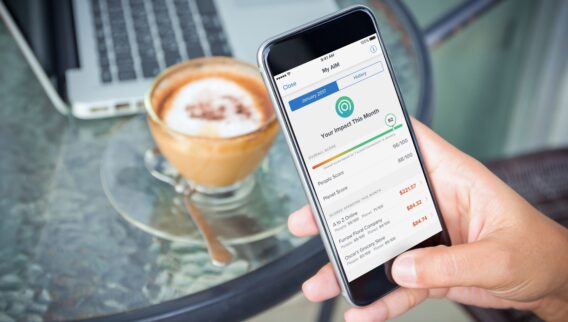Thanks to the power of digital banking, many consumers have never set foot inside a brick-and-mortar bank. From the ability to access everyday banking functions via a computer or mobile device to empowering cashless transactions at a wide swath of stores, it would appear that digital banking isn’t just the future. It’s now.
But what exactly is “digital banking,” and what does it mean for your finances?
The information below can help you get up to speed on what digital banking is, what it includes and other new terminology you may have heard in conversations about digital banking. You’ll also be able to explore the benefits of digital banking and how it impacts the way you bank today and tomorrow.
Digital Banking Defined
While it may be used in many different ways online and elsewhere, the term digital banking, essentially, combines online and mobile banking services under one umbrella.
Online banking means accessing banking features and services via your bank’s website from your computer. You may log into your account to check your balance or pay your electricity bill. You can access additional banking features, such as applying for a loan or credit card, at many banks via your online banking portal.
Online banking lets you sit down at your computer and tackle many of your personal finance needs without ever having to leave your home, something for which the family pet is likely most grateful.
Mobile banking means using an app to access many of those same banking features via mobile devices such as smartphones or tablets. These apps are proprietary, issued by the bank where you hold your account, and usually use the same login information as your online banking portal.
Designed for people on the go, mobile banking apps tend to include the most used banking features, such as mobile check deposit, funds transfers and bill payment. They also often have convenient features like peer-to-peer payments through systems like Zelle. Banks also may use their mobile apps to send customers banking alerts such as fraud detection and low balance notifications.
Here’s a visual equation that sums up (literally) digital banking:
Online Banking + Mobile Banking = Digital Banking
Online banking in the U.S. has its roots back in the 1990s. In October 1994, Stanford Federal Credit Union was the first institution to let its customers access banking functions via the new World Wide Web. By the time the 21st century rolled around, it’s estimated that 80% of U.S. banks offered their customers the ability to bank online.
As mobile devices gained popularity and adoption, banks were encouraged to put their services at their customers’ fingertips and create their own mobile banking apps. As of its most recent biennial, “How America Banks,” the FDIC reported that 34% of Americans used mobile banking as their primary way of accessing their accounts in 2019.
Together, online and mobile banking create the digital banking umbrella, giving people access to banking wherever they may be—or, in some cases, wherever they’re graced with secure Wi-Fi and strong cell signal.
Who Offers Digital Banking?
You can find digital banking via two primary sources: brick-and-mortar banks and credit unions, and online banks. Neither source is better than the other. Instead, some consumers may find one to be a better fit than the other for their needs.
Digital Banking Via Brick-and-Mortar Financial Institutions
For customers who appreciate the ability to stop by a branch to perform some of their banking functions, brick-and-mortar banks and credit unions are the natural choices for their bank accounts. These traditional banking institutions also usually offer online access and a proprietary mobile app to make everyday banking functions as accessible as possible for their customers.
Brick-and-mortar banks and credit unions carry their own FDIC and NCUA insurance, which insures depositors’ funds up to $250,000 per depositor, per bank, for each account ownership category.
Digital Banking Via Online Banks
Many online banks have come to market in recent years, offering customers benefits like higher-than-average savings account yields and intuitive online experiences. Since you generally can’t stop into a branch, these online banks cater exclusively to those who don’t need a branch for their banking functions.
Online banks can take various forms, all of which challenge the high fee, low yield brick-and-mortar banking model. In some cases, they may be affiliated with a traditional brick-and-mortar bank, serving as its online division. Or they may operate solely online. More recent fintech iterations have included what are referred to as neobanks or challenger banks.
The majority of these online banks offer slimmed-down banking functions, low- to no-fee structures and higher-than-average interest rates in exchange for no in-person branch experience. With a more streamlined, online and mobile-only product offering, these banks can reduce operational costs and help more people access banking services, a potentially vast benefit to the underbanked and unbanked communities.
You may find that some online banks may not issue loans or credit cards, as a way to reduce their risk. Other online banks, like Ally, started as lenders, and offer a wide range of services like online brokerage accounts, loans and credit cards.
Additionally, some online banks aren’t fully chartered banks themselves and partner with larger banks to provide essential services like checking and savings functions, along with insurance to protect depositors. These partnerships are usually transparent to you as the account holder and don’t change the way your online bank account functions compared to a brick-and-mortar, major bank counterpart.
Online banks are also expanding beyond personal banking into the business world. Small business owners and startups can access several different online business banks designed for their needs, putting the best business banking experience as close as your desktop or mobile device.
What Are the Benefits of Digital Banking?
Digital banking offers a number of benefits for both consumers and business owners. Here are several:
- Access. With both desktop and mobile access to your bank accounts available, digital banking means you’re not beholden to bank hours to manage your finances.
- Better rates and lower fees. With online banks driving fees down, consumers have choices beyond their local brick-and-mortar financial institutions. It’s easy to compare rates and fee structures to find the best bank for your needs.
- Equity. Upstart online banks level the banking access playing field by reaching unbanked and underbanked communities that rely heavily on mobile phones but may not have access to physical bank branches.
What Are the Drawbacks to Digital Banking?
Digital banking, while highly convenient and easy to access, isn’t without its challenges.
- Downtime. If you rely solely on an online bank, you could be challenged to access your accounts should your bank experience an online or mobile app outage and there’s no branch for you to visit instead.
- Learning curve. For those who aren’t tech-savvy, online banking and mobile banking apps might be a bit much to digest.
- Security. There’s always the chance that your username and password could be hacked; however, online banks pursue the same degree of risk-reducing security protections, such as multi-factor authentication, as brick-and-mortar banks do.
For those considering one of the many online banks available, be sure to inquire about FDIC or NCUA insurance. You’ll want to understand which financial institution an online bank is partnered with to ensure that your deposit funds are insured. If you can’t readily find this information, you may want to look for another online bank.
What Does Digital Banking Mean for You?
Digital banking, inclusive of online and mobile banking, gives people more ways than ever to access the functions they need to keep their finances in order. As the Covid-19 crisis has demonstrated, in-person services, in general, can’t be taken for granted, and banking services are no different.
When banks are able to create pathways that let people conduct their banking business remotely, they’re ensuring that your finances don’t grind to a halt even when the ways people do business have changed.
Find The Best Online Banks Of 2025








